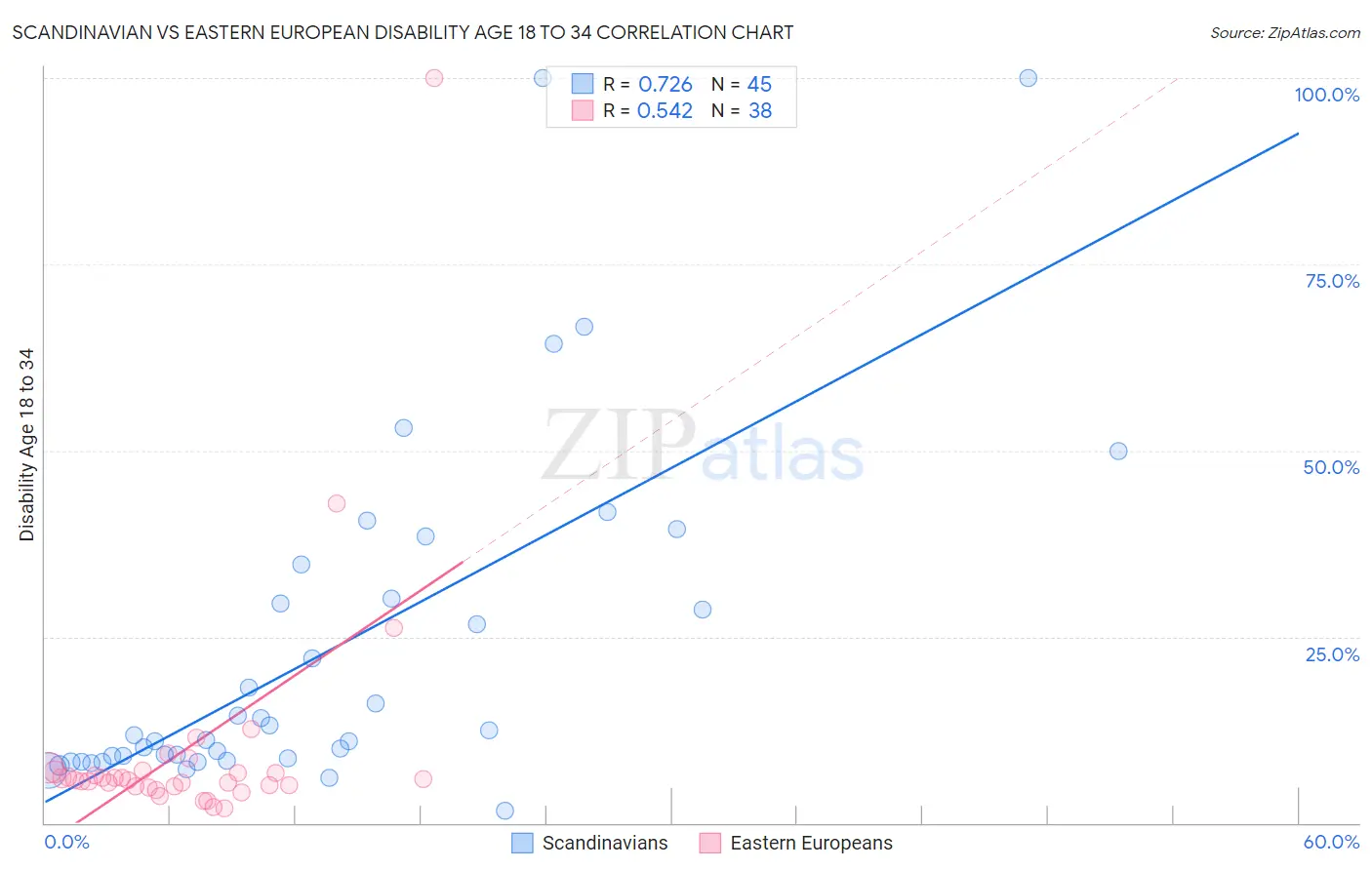Scandinavian vs Eastern European Disability Age 18 to 34
COMPARE
Scandinavian
Eastern European
Disability Age 18 to 34
Disability Age 18 to 34 Comparison
Scandinavians
Eastern Europeans
7.7%
DISABILITY AGE 18 TO 34
0.0/ 100
METRIC RATING
293rd/ 347
METRIC RANK
6.5%
DISABILITY AGE 18 TO 34
65.1/ 100
METRIC RATING
166th/ 347
METRIC RANK
Scandinavian vs Eastern European Disability Age 18 to 34 Correlation Chart
The statistical analysis conducted on geographies consisting of 470,294,545 people shows a strong positive correlation between the proportion of Scandinavians and percentage of population with a disability between the ages 18 and 35 in the United States with a correlation coefficient (R) of 0.726 and weighted average of 7.7%. Similarly, the statistical analysis conducted on geographies consisting of 459,325,923 people shows a substantial positive correlation between the proportion of Eastern Europeans and percentage of population with a disability between the ages 18 and 35 in the United States with a correlation coefficient (R) of 0.542 and weighted average of 6.5%, a difference of 17.6%.

Disability Age 18 to 34 Correlation Summary
| Measurement | Scandinavian | Eastern European |
| Minimum | 1.6% | 1.9% |
| Maximum | 100.0% | 100.0% |
| Range | 98.4% | 98.1% |
| Mean | 23.4% | 9.8% |
| Median | 11.8% | 5.8% |
| Interquartile 25% (IQ1) | 8.4% | 4.9% |
| Interquartile 75% (IQ3) | 32.4% | 6.9% |
| Interquartile Range (IQR) | 24.0% | 2.0% |
| Standard Deviation (Sample) | 23.3% | 16.6% |
| Standard Deviation (Population) | 23.0% | 16.4% |
Similar Demographics by Disability Age 18 to 34
Demographics Similar to Scandinavians by Disability Age 18 to 34
In terms of disability age 18 to 34, the demographic groups most similar to Scandinavians are Black/African American (7.7%, a difference of 0.060%), Immigrants from Cabo Verde (7.7%, a difference of 0.15%), Tlingit-Haida (7.7%, a difference of 0.16%), Irish (7.7%, a difference of 0.28%), and Slovak (7.7%, a difference of 0.33%).
| Demographics | Rating | Rank | Disability Age 18 to 34 |
| Celtics | 0.0 /100 | #286 | Tragic 7.6% |
| Norwegians | 0.0 /100 | #287 | Tragic 7.6% |
| Whites/Caucasians | 0.0 /100 | #288 | Tragic 7.6% |
| Immigrants | Nonimmigrants | 0.0 /100 | #289 | Tragic 7.6% |
| Slovaks | 0.0 /100 | #290 | Tragic 7.7% |
| Irish | 0.0 /100 | #291 | Tragic 7.7% |
| Blacks/African Americans | 0.0 /100 | #292 | Tragic 7.7% |
| Scandinavians | 0.0 /100 | #293 | Tragic 7.7% |
| Immigrants | Cabo Verde | 0.0 /100 | #294 | Tragic 7.7% |
| Tlingit-Haida | 0.0 /100 | #295 | Tragic 7.7% |
| Cape Verdeans | 0.0 /100 | #296 | Tragic 7.7% |
| Pueblo | 0.0 /100 | #297 | Tragic 7.7% |
| Dutch | 0.0 /100 | #298 | Tragic 7.7% |
| Germans | 0.0 /100 | #299 | Tragic 7.7% |
| Scottish | 0.0 /100 | #300 | Tragic 7.7% |
Demographics Similar to Eastern Europeans by Disability Age 18 to 34
In terms of disability age 18 to 34, the demographic groups most similar to Eastern Europeans are Immigrants from Northern Europe (6.5%, a difference of 0.080%), Immigrants from Moldova (6.5%, a difference of 0.16%), Immigrants from Hungary (6.5%, a difference of 0.36%), Russian (6.5%, a difference of 0.37%), and Immigrants from Nigeria (6.5%, a difference of 0.42%).
| Demographics | Rating | Rank | Disability Age 18 to 34 |
| Dominicans | 73.6 /100 | #159 | Good 6.5% |
| Immigrants | Southern Europe | 72.5 /100 | #160 | Good 6.5% |
| Arabs | 72.3 /100 | #161 | Good 6.5% |
| South Africans | 71.7 /100 | #162 | Good 6.5% |
| Immigrants | Denmark | 71.7 /100 | #163 | Good 6.5% |
| Immigrants | Nigeria | 70.4 /100 | #164 | Good 6.5% |
| Immigrants | Hungary | 69.6 /100 | #165 | Good 6.5% |
| Eastern Europeans | 65.1 /100 | #166 | Good 6.5% |
| Immigrants | Northern Europe | 64.1 /100 | #167 | Good 6.5% |
| Immigrants | Moldova | 63.1 /100 | #168 | Good 6.5% |
| Russians | 60.2 /100 | #169 | Good 6.5% |
| Immigrants | Bahamas | 57.9 /100 | #170 | Average 6.6% |
| Bahamians | 55.5 /100 | #171 | Average 6.6% |
| Ghanaians | 54.7 /100 | #172 | Average 6.6% |
| Immigrants | Mexico | 54.1 /100 | #173 | Average 6.6% |